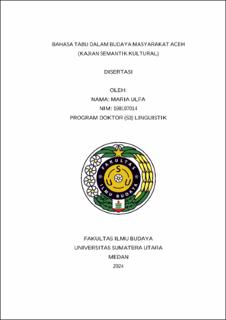| dc.description.abstract | This research is motivated by the phenomenon of language shifts in the Aceh community, especially among the young generation who shifted the Aceh language and no longer understand Aceh customs and values, including the values and norms of the use of taboo language. Taboo, in fact, is not only known as a form of swearing but taboo can be determined by the existence of moral and ethical education that takes place within an ethnic group. Based on this, the study aims to categorize the types of taboo as well as analyze the meaning of the taboo and the patterns of configuration of the values and norms of taboo in Aceh society, in particular in the Langsa and Eastern Aceh districts. The data in this study is a taboo expression of words, phrases, and sentences. The data of this research was then collected using the simak ‘observation method and cakap ‘interview’ Method. The data that was collected was then analyzed using padan ‘matching’ and Agih ‘dividing’ methods. The results of this study show that the categorization of taboo that exists in Langsa city and. East Aceh about elevent categories based on its reference: taboo of objects, taboo of animal names,taboo of human mental, taboo of disease, taboo of kinship, taboo of human character,taboo of ghost, taboo part of body, taboo aktivity, taboo expression of praise, taboo expression of disappointed. The meaning contained in the Aceh language taboo is pronounced using the natural semantic metalanguage theory ( NSM), then the natural meaning is expressed by the speech elements, Furthermore, the natural meaning of taboo language is expressed by combining with such elements including mental predicate elements, like thinking and knowing; attributes, like bad; substantives, like “you, someone, something, or body; elements of action, event, and movement, like happening; and partonomic elements, such as parts. Values and norms are configured in the high-level and low-level script, which consists of respectful value, tolerance values, religious values, and moral values, whereas the norms are: norms of respect for human beings, norms of respect for other entities, norms of expressing thoughts and hopes, norms of obedience, and norms of politeness. | en_US |


